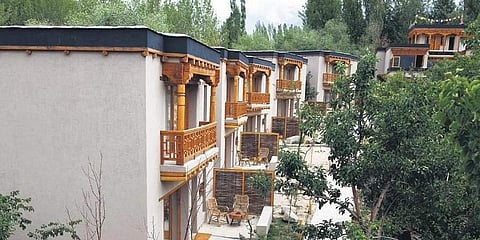
- LIFESTYLE
- FASHION
- FOOD
- ENTERTAINMENT
- EVENTS
- CULTURE
- VIDEOS
- WEB STORIES
- GALLERIES
- GADGETS
- CAR & BIKE
- SOCIETY
- TRAVEL
- NORTH EAST
- INDULGE CONNECT

Rigzin Lachic is on a high. She has finally realised her dream of launching a sustainable boutique stay, Dolkhar, in her native place, called the roof of the world, Leh. Having grown up in Delhi, where her Air Force officer father was posted, her interaction with her roots was limited to the time spent with her grandparents in their village.
Her exchanges with her grandmother revolved around how Lachic’s education would help the Ladakhis. “Those conversations stayed with me,” she says. After graduating from college in 2013, Lachic landed an IT job in Tokyo and her Leh business plan took a backseat. “Though I led the good life, I felt I wasn’t contributing much to the world.
The dream to return home was a recurring one,” the 31-year-old admits. In 2017, the sudden death of her grandmother came as a jolt and Lachic packed her bags for India. She had decided not to let her long chats with the matriarch go waste. The one-acre apple orchard in Lower Tukcha Road in Leh, which her grandmother owned, held fond memories. Lachic has fittingly named the seven-villa luxury hotel with
a combination of words—her grandmother’s name was Dolkar, and khar means ‘palace’ in the Ladakhi tongue.
Dolkhar, built in traditional Ladakhi architectural style, took Lachic four years to complete. She put together an eclectic team to create the dream. “I couldn’t find a local architect who knew Ladakhi architecture since they had all studied outside. I finally hired a 70-year-old gentleman who has been involved in the construction of monasteries and palaces,” she informs.
Back in the day, when it didn’t rain much in Ladakh, all buildings were made using local sand. With climate change, it now pours during the monsoon. “We had to alter some of the building materials to ensure it can withstand rains,” Lachic adds. Local willow and poplar wood were used for the roof. Each of the seven villas has stone walls, a wooden balcony called ‘rabsal’ and a private patio.
The interiors have been done by 40 Ladakhi craftsmen. Sheep and yak wool rugs handwoven by the women of Kharnak and Changtang bordering Tibet adorn the floor. Even the dustbins are local—wooden barrels called dems. Eat local is Dolkhar’s motto—the all-vegetarian fare at the Tsas by Dolkhar restaurant is cooked with local ingredients in Ladakhi style, using Japanese and European techniques to give it
a modern twist.
But construction alone didn’t satisfy Lachic’s drive. Somewhere along the way, she founded a crafts co-operative of 40 craftspeople. Their works are now displayed in a small shop in Leh and are promoted on social media. “I had just contacted them to buy their products, and then discovered that their crafts were dying; a reason why they were abandoning the traditional life to work as labourers or taxi drivers,” she reflects. She now promotes and markets local craft pro- ducts through an Instagram page, @hatti.ladakh. In the end, Lachic walked the talk with her grandmother, not just for herself, but also for the Leh she loves.